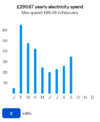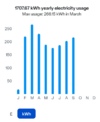The second battery will cost around £1000 fitted, the app on the phone has a switch to add standing charge or show without standing charge. The formula you have given is spot on, now entered as an excel sheet, second battery is 3.2 kWh so on day given as an example it will means most power used will be off peak. But second advantage, think the inverter can handle 5 kW but battery max charging rate is 2 kW so even with half charged battery I end up exporting and producing over 2 kW, solar is rarely over 4 kW so second battery means will not export as much, as well as using more off peak and less peak power.
We will still need the grid for a shower etc during peak times, but in the main we will use no peak power.
Before solar the monthly payment was £173.90
After fitting went to £119.70
After off peak started £81.35
And we are £984.36 in credit so needs to be reduced further.
Actual usage can only really see since smart meter fitted,

Jan smart meter fitted, hence low, the marked drop April to May was due to using off peak, set to kWh rather than £

the sharp drop is not there, a rough calculation solar saving around £40 per month, and battery around £20 per month existing battery 3.2 kWh, but also first battery means we have an UPS so heating still works when we have a power cut, also freezers, so there was an added benefit, piece of mind, the wood store in case we need to light a fire is reduced.
However we have also altered life style a little, the three machines dish washer, washing machine, tumble drier either over night or before 4 pm depending of how much solar, and during day not run together, even coffee would make two cups at same time, now one after the other. The latter can return to two together once we have second battery if we wanted.
All in all yes solar has been good, but value for money the battery has done better than solar, don't think solar would have really worked without the battery, as you can't rely on getting enough solar to run a tumble drier for 2.5 hours, you would have to switch it off each time a cloud came over.
Program has worked well
clearly the battery will help more in winter than summer using 602 watt/hours as on the 9th battery will do nothing really, but it does seem on average it will pay for its self. Thanks.



